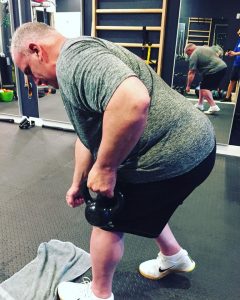When we hear the word athletics, we automatically think of Michael Jordan or Emmitt Smith, individuals capable of accomplishing great movements with their bodies. But you don’t have to be an elite athlete to train your body to move better. When we only think about working out to get a six-pack or bigger biceps, because the magazines tell us that’s what we should look like, we miss the opportunity for exercise to enhance our quality of life. Rather than moving in respect to our human anatomy we contort our bodies and make ourselves so sore that we can barely walk the next day or can’t get on and off the toilet.
Human anatomy dictates the way our body functions based on the way our muscles connect with each other. The less connected your muscles are during movement the more likely your chance of injury is. Since all of our muscles are connected they never work independently, so isolating your body when you workout can potentially disrupt your muscle connections and cause your body to compensate when you move. When you move, your body is conditioned to absorb force in your joints instead of transmitting the force through a connected web of muscles. It’s like your muscles are clocking out early every day and your joints are working over time without pay, because isolated exercises utilize your joints as levers instead of transmitting force through our muscle chains. The goal with exercise should be to connect one chain of muscle with another through reciprocation, since human movement entails reciprocal forces, like opposing limbs uniting when we walk. The more your muscles work in harmony with each other, the more efficient your body will move, decreasing the likelihood of injuries, aches, and pains.
Since we all walk, an exercise like the barbell squat won’t translate as efficiently to the patterns we use on a consistent basis. The glutes developed primarily through walking and running mechanics so for most humans, squatting isn’t the most efficient way to condition your glutes for real world use. If you’re intent is to develop strength through lifting free weights then make sure the strength you develop can be transferable to other scenarios. You limit yourself by getting really strong at a particular lift but the only time you can apply that strength is when you’re performing that exercise. When you’re out with friends, walking your dog, or running errands, strength manifests in the form of comfort that you have in that scenario. If you’re standing in a group of friends and you can’t stand without leaning against a wall or shifting your weight from one leg to another, you have no relative strength- your strength only manifests when you’re in the gym doing your exercise. If fitness is meant to enhance our lives then why would you want your hours spent working hard in the gym to only apply to when you’re in the gym? Not all functional training is truly functional and when you’re trying to function and exist in the real world on a daily basis your body should be prepared.
When you exercise, prioritizing Functional Patterns of movement will condition your body for operating in reality. Training for athletics, or the goal of moving better, will outweigh the benefits of training only for aesthetics, a goal of only looking better. Working out to just build a bigger chest and arms, without taking into consideration that too much muscle mass can lead to imbalances in the body, can become disastrous for how well your body can move. Exercise patterns should mirror the mechanics of how humans move. A foundational human movement is walking, so when you exercise to only look better naked, you neglect the basic principle that the body is designed to move outside of the confines of weight machines and exercises that restrict force transmission through the entire web of muscles. Once the muscles are conditioned to support your body when you walk, without compensations like swaying hips, knees turning in, arms not moving, or a tilted ribcage, other movements, inside and outside of the gym, are streamlined. So, by addressing the way your body moves when you walk, other movements like playing ball with your friends, running a 5k, playing tennis or golf, and performing exercises that respect human body mechanics, are automatically improved.
Athletic training and aesthetic training can go hand in hand, when all systems of the body are operating in harmony, less energy is wasted and more muscle tissue is utilized, so eventually your goal of looking better naked will be achieved. The more muscles that you can integrate into one rep, the more energy you expend, so more calories are being burned per workout. Pair that with the proper nutritional habits, and it’s an efficient recipe for weight loss. Weight loss that comes as a result of better body mechanics and natural movement, not beating your body up with traditional weight lifting that leaves you hurting and injury prone so you’re unable to workout and the weight just piles on. Respect the way your body was designed to operate and keep yourself in the game so that you can move well and sustain a healthy weight for the entirety of your life.











